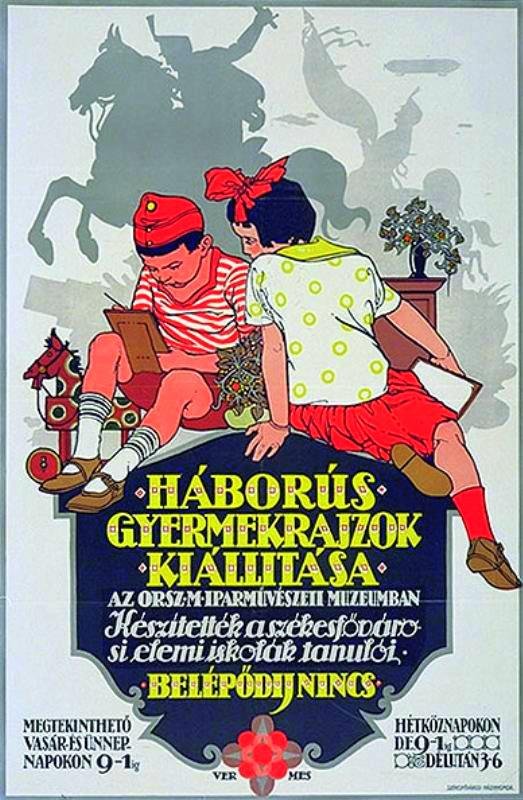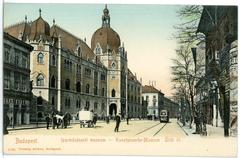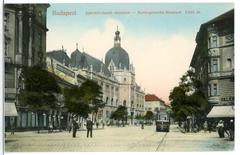
Museum of Applied Arts Budapest: Visiting Hours, Tickets & Visitor Guide
Date: 14/06/2025
Introduction
The Museum of Applied Arts in Budapest is a remarkable testament to Hungary’s rich tradition of craftsmanship, innovative design, and national identity. Since its founding in 1872, the museum has stood at the forefront of collecting, preserving, and promoting applied arts—objects that blend function and artistry—serving as a bridge between historical craftsmanship and the contemporary creative scene. Its extensive holdings, architectural splendor, and dynamic educational programs make it one of Central Europe’s most important cultural institutions (official museum site, Museum of Applied Arts official site).
Currently, the museum is undergoing an ambitious restoration project slated for completion in 2026. During this time, collections remain accessible online, and selected exhibitions are hosted at satellite venues across Budapest. This guide provides up-to-date visitor information, explores the museum’s history and architecture, highlights key collections, and offers practical tips for making the most of your visit.
Table of Contents
- Origins and Foundation
- Architectural Significance
- Evolution of Collections and Exhibitions
- Visiting Information
- Restoration and Modernization
- Role in Hungarian and European Cultural Heritage
- Influence on Contemporary Design and Education
- Notable Milestones and Events
- Frequently Asked Questions (FAQ)
- Visuals and Media Suggestions
- Special Events and Cultural Context
- Visitor Experience and Tips
- Digital Access and Online Collections
- Future Developments
- Plan Your Visit Today!
Origins and Foundation
Founded in 1872, the Museum of Applied Arts in Budapest emerged during a national awakening within the Austro-Hungarian Empire. Inspired by institutions like London’s Victoria and Albert Museum and Vienna’s Museum of Applied Arts, its mission was to champion Hungarian craftsmanship and industrial design (official museum site). The museum’s establishment was closely tied to the Hungarian National Industrial Association, with initial collections drawn from donations, state acquisitions, and leading Hungarian manufacturers.
Architectural Significance
The museum is an architectural jewel of Art Nouveau, designed by Ödön Lechner—often called the “Hungarian Gaudí.” Completed in 1896 for Hungary’s Millennium celebrations, the building fuses Hungarian folk motifs with Islamic and Eastern influences, most notably in its vibrant green Zsolnay ceramic-tiled roof and detailed ornamentation (imm.hu, budapest-city-guide.com). Inside, a grand central hall with a glass dome, intricate ironwork, and colorful mosaics create a stunning atmosphere that reflects Hungary’s national pride and design innovation.
Evolution of Collections and Exhibitions
The museum’s collections have grown to more than 200,000 objects, including textiles, ceramics, glass, metalwork, furniture, graphic arts, and contemporary design. Its holdings span Hungarian folk art to contemporary works, with a strong focus on both national and international applied arts traditions (Hungary Budapest Guide, Arts & Culture Google). Key collection areas include:
- Furniture and Interior Arts: From Renaissance to Modern.
- Ceramics and Glass: Herend and Zsolnay porcelains, Art Nouveau vases, stained glass.
- Textiles and Costumes: Tapestries, carpets, folk embroidery.
- Metalwork and Jewelry: Silver, gold, weapons, and ecclesiastical objects.
- Graphic Arts and Design: Prints, posters, design drawings.
The museum also hosts regular temporary exhibitions, including thematic displays on Art Nouveau, folk art, and design history.
Visiting Information
Visiting Hours
- Tuesday to Sunday: 10:00 AM – 6:00 PM
- Closed: Mondays and public holidays
Note: The main building at Üllői út 33-37 is closed for renovation until 2026. Check the official website for current information and exhibitions at alternative venues.
Tickets and Admission
- General Admission: 2,000–2,500 HUF
- Discounts: Students, seniors, EU citizens, and groups
- Family Tickets: Available
- Free Entry: Children under 6, seniors over 70, Budapest Card holders, and on national holidays (March 15, August 20, October 23) and selected weekends (Buddypest)
- Purchase: Online or at the museum entrance
Accessibility
- Wheelchair access, ramps, and elevators are available
- Assistance for visitors with disabilities upon request
- Multilingual signage and audio guides
Guided Tours and Audio Guides
- Guided tours offered in multiple languages (advance booking recommended)
- Audio guides available via app or rental
Travel Tips
- Best Time to Visit: Weekday mornings for fewer crowds
- Public Transport: Metro M3 (Corvin-negyed), Tram lines 4/6, and various bus routes
- Parking: Limited; public transport recommended
Nearby Attractions
- Central Market Hall
- Hungarian National Museum
- Corvin Plaza Shopping Center
- Holocaust Memorial Centre
- Great Synagogue
Restoration and Modernization
The museum is undergoing a comprehensive €80 million restoration, scheduled for completion in 2026. The project will triple exhibition space, restore the historic building, and create a new annex for contemporary design displays (Daily News Hungary). During renovation, exhibitions are hosted at alternative sites including the György Ráth Villa and Hopp Ferenc Museum of Asian Art. Digital initiatives ensure ongoing access to the museum’s collections (Arts & Culture Google).
Role in Hungarian and European Cultural Heritage
The Museum of Applied Arts serves as a vital guardian of Hungarian and European decorative arts. Its collaborations with artists, designers, and international institutions foster cross-cultural exchange. The museum’s iconic building is an architectural landmark, influential in the development of Hungarian Art Nouveau (Szecesszió) and modern design (Visit Hungary).
Influence on Contemporary Design and Education
The museum maintains strong ties with educational partners such as the Moholy-Nagy University of Art and Design, supporting research, internships, and public programs that bridge tradition and innovation. Its exhibitions and workshops stimulate dialogue between established and emerging creative voices.
Notable Milestones and Events
- 1872: Museum founded
- 1896: Iconic building inaugurated
- 20th Century: Collection expansion, survived wars and political shifts
- 2017–2026: Major restoration and digital expansion
Visuals and Media Suggestions
- Exterior Views: Iconic green Zsolnay-tiled roof and dome (alt text: “Museum of Applied Arts Budapest exterior with green Zsolnay-tiled roof”)
- Interior: Grand atrium with mosaic flooring and natural light (alt text: “Grand atrium of Museum of Applied Arts Budapest with mosaic flooring”)
- Collection Highlights: Herend porcelain, Ottoman carpets (alt text: “Herend porcelain collection at Museum of Applied Arts Budapest”)
- Map: Museum location and nearby attractions
Special Events and Cultural Context
- Night of Museums (June): Extended hours and special programming (Travelling Mandala)
- World Art Nouveau Day (June 10): Themed exhibitions and workshops
- WAMP Design Fair: Annual contemporary design event (Budapestbylocals)
Visitor Experience and Tips
- Plan ahead by checking renovation updates and current exhibitions
- Take advantage of free entry on national holidays and selected weekends
- Use the online collection for remote exploration
- Combine your museum visit with nearby historical sites for a full cultural day
- Follow the museum and Audiala app for the latest news and guided audio tours
Digital Access and Online Collections
Explore nearly 44,000 collection items online through the museum’s digital database and Google Arts & Culture platforms. Virtual tours and multimedia resources are available for remote visitors.
Future Developments
Upon reopening in 2026, the museum will feature expanded galleries, modern amenities, and a renewed focus on contemporary design alongside its historical treasures. Visitor numbers are expected to reach 300,000 annually (Daily News Hungary).
Frequently Asked Questions (FAQ)
Q: What are the Museum of Applied Arts Budapest visiting hours?
A: Tuesday to Sunday, 10:00 AM–6:00 PM; closed Mondays. Main building closed for renovations—check official website for current info.
Q: How can I buy tickets?
A: Purchase online via the official website or at the entrance (when open).
Q: Is the museum accessible?
A: Yes, elevators, ramps, and assistance are provided for visitors with disabilities.
Q: Are guided tours available?
A: Yes, in multiple languages; advance booking is recommended.
Q: Are there free entry days?
A: Yes, on national holidays and selected weekends (Buddypest).
Q: Where can I see exhibitions during renovations?
A: At the György Ráth Villa, Hopp Ferenc Museum, and online platforms.
Conclusion and Call to Action
The Museum of Applied Arts Budapest is an essential destination for anyone passionate about art, design, architecture, and Hungarian heritage. Even during its restoration, the museum offers enriching experiences through digital collections and temporary exhibitions. Plan ahead, check for updates, and utilize resources like the Audiala app for guided tours and insider insights.
For the latest information, visit the official museum website. Explore more about Budapest’s rich cultural scene and historical sites to make the most of your journey.
References and Useful Links
- Museum of Applied Arts Budapest Official Site
- Museum of Applied Arts official site
- Hungary Budapest Guide
- Daily News Hungary - Museum of Applied Arts closed for years due to restoration
- Arts & Culture Google - Museum of Applied Arts Budapest
- Budapest City Guide - Museum of Applied Arts
- Visit Hungary - A Jewel of Art Nouveau: The Budapest Museum of Applied Arts
- Buddypest - Free Museums
- Triphobo - Museum of Applied Arts Budapest
- IMM - History of the Building
- Budapest.net - Museum of Applied Arts
- UrTrips - Museum of Applied Arts Budapest
- Travelling Mandala - Budapest in June
- Budapestbylocals - Visit Budapest in June









































































































































































